Online bookings
24 hours a day
0044 (0) 20 3239 1595
English Phone
Mon-Fri: 8-16:00 GMT
Customer Service
The Sagrada Familia is unquestionably the symbol of the city of Barcelona. This is the one place that no tourist should miss out on seeing as much for the stunning stroll around the inside of the church as for the experience itself.
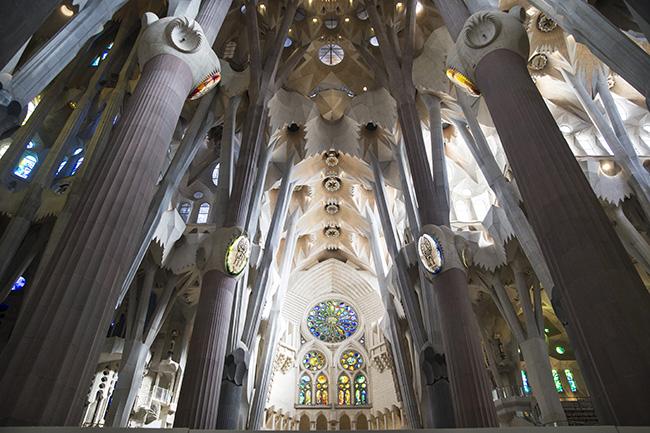
The History of the Sagrada Familia
Useful Information: opening times, entry, how to get there
Interesting information about the Sagrada Familia.
Five generations have already passed since the first stone that is part of the majestic church of The Holy Family was laid: this took place in 1882 when the ambitious project of the genius that was Antoni Gaudí was actually launched. A man whose architectural style and techniques were unique the world over. Gaudí conceived this place of worship taking the traditions of earlier Gothic and Byzantine cathedrals and managed to achieve a symbiosis between the shapes and symbolism of Christianity, taking his inspiration from the natural world and paying great attention to light and color. As a result of this, each one of the famous eighteen towers of the Sagrada Familia has its own strong symbolism: Jesus Christ is located in the center, surrounded by the four evangelists; the unique apse tower which is crowned by a star, represents the Virgin Mary and the twelve remaining towers, the twelve apostles. After the death of Barcelona's most famous architect in 1926, work on the construction of the Sagrada Familia continued without interruption, despite the horrendous acts of vandalism which were suffered during the Civil War: it is estimated that the building will reach completion in 2026, exactly 100 years after the death of its creator and in accordance with his original wishes.
The opening times for the Sagrada Familia ,throughout the year, are from 09:00 until around 19:00 in the evening, except at Christmas, when the doors close at 14:00. The cost of entry can vary from €15.00 to €29.00 depending on the type of visit that you choose, (for example, if you wish to use an audio-guide or if you wish to visit the towers). The church is located in the central area of the city, although it is quite a distance from the busiest streets, if you want to get there without any stress: if you are coming from the center, you can walk along Carrer d'Aragó in an easterly direction and then climb towards Carrer de la Marina. In any event, it is also easy to travel there on the Metro lines either on the Violet L2 or the Blue L5 towards the station of the same name. There are also plenty of buses that travel to the area of the Sagrada Familia: routes 19, 33, 34, 43, 44, 50, 51, B20 and B24. It is also worth knowing that students who carry a student card can take advantage of discounted pricing, as well as children, pensioners and groups.
Of the eighteen towers that were envisioned by Gaudí, at present, only eight have actually been built and those who wish to visit them should not succumb easily to physical fatigue, just be ready for a slight financial surprise. In fact, on the basic ticket, a visit to the towers is not included which can solely be experienced by using the lift to ascend, whereas the descent is only possible via the entrancing spiral staircase with its spectacular displays of light. In 1914, Antoni Gaudí decided to abandon all the other projects he had in hand in order to dedicate himself completely to the realization of the basilica of The Holy Family, in which, his spirit lives on today. Barcelona's most illustrious architect was buried in the chapel of the Virgen del Carmen, right inside the church's crypt.
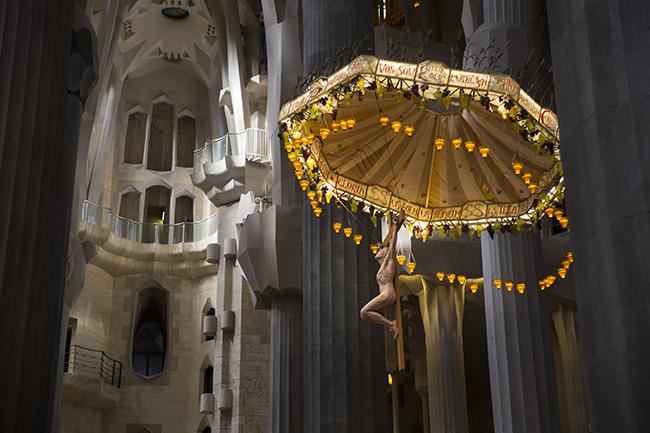
Barcellona.shop can provide you with the opportunity of visiting the Sagrada Familia by booking a fascinating tour right on this web page. You can choose the shared tour of the Sagrada Familia, on which a bilingual tour guide will relate the history of the exterior of this amazing church and will then lead the group on a tour of the interior which will take everybody's breath away. For an complete visit, you can choose the tour of the S. Familia + the towers, which will allow you to use the lift to go up one of the basilica's original towers, enabling you to admire stunning views of the city from on high. When it comes to the descent, this will be made via the extraordinary spiral staircase. There is also the possibility of visiting Park Güell and the Sagrada Familia, with transport included! This is a great opportunity to experience a day of effortlessly exploring two of Barcelona's most stunning attractions: in fact, by buying one of our tours, you will already have your entry to these tourist attractions included so you won't have to worry about how to go about making a booking.
The Facade of the Passion is located on the west side of the Basilica, overlooking Carrer Sardenya and is a work by Josep Maria Subirachs who worked on it from 1987. His style is unmistakable: straight, geometric lines which form a strong contrast with the full and also cavernous style of the building, the positive and the negative in regards to symbolism. At the same time, the sculptor re-emphasizes Gaudí's project in accordance with the original designs which convert the Sagrada Familia into an open book about the stories that are told in The Bible and in particular, in the Gospels. The result is an ordered set of sculptural groups that relate a story, an anecdote or even a legend.
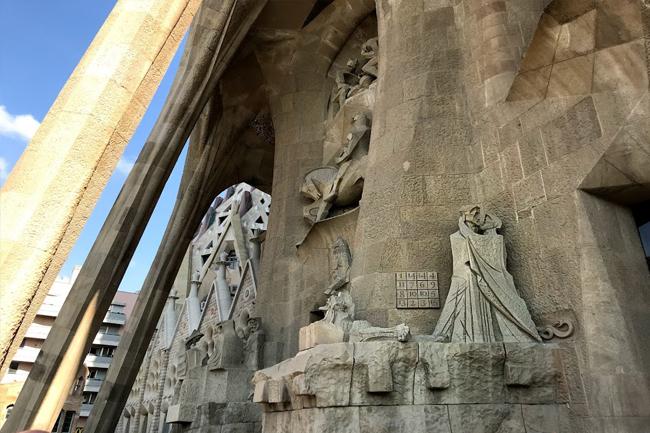
The Facade of the Passion actually provides a certain order in which it should be viewed chronologically and follows the form of an "S" starting at the bottom left hand side until you reach the highest point on the right. In this order, you will see representations of the Last Supper which is seen first, followed by the sculpted image of a soldier by an olive tree in which, where you can see Malchus's ear, the slave who accompanied the soldiers who were led by Judas Iscariot to arrest Jesus in the Garden of Olives. This representation is explained in the story of The Passion as it is narrated in The Bible: Peter suddenly woke up on the arrival of the soldiers and with his sword, he cut off the ear of Malchus but he was stopped by Jesus who said the words "All who draw the sword shall perish by the sword." The story on the Facade of the Passion at the Sagrada Familia continues with Judas's kiss of betrayal, at whose feet lies a serpent which symbolizes evil and which is divided by the first of the three large doors of the facade. On the lower part of the Facade of the Passion, there are actually three doors, each of which reflects the voices of the evangelical texts which narrate the various stages of Christ's Passion: on the door to the left, can be seen the prayer from the Garden of Olives, on the central door, the interrogation by the Sanhedrin is represented and on the right hand door, there is reference to Pontius Pilate and the crown of thorns which also comes from an extract of the text of Dante's "Paradise." All the texts that can be seen are written in Catalan.
The story continues with the flagellation which shows Christ tied to a column and which is divided into four parts which make reference to the symbolism of the cross. The iconography of the Passion is also explicit in the representation of the Three Days of the Passion which are represented by a knot, (which symbolizes martyrdom), a cane (which represents scorn) and a dwarf palm (which symbolizes the Resurrection). It carries on with the narration of Peter's denial of Christ three times before the cock crows and a labyrinth can be seen which represents the sacrifice that must be made in order to reach God. Also visible on the Facade of the Passion is a "magic square" which is also referred to as "the magic table" or the "esoteric table" whose mathematical combinations always come to the number 33: Christ's age when he died. Going up on the left, you can see a man with a spear and the soldiers who are fighting over Christ's robes in a game. The main scene is that of the Crucifixion in which a skull can be seen beneath the cross, a symbol of death which is positioned on a rough stone which then leads to the Resurrection in the Holy Sepulcher of the body and soul after death.
The Facade of the Nativity is the only one to have been finished whilst Gaudí was still alive and was constructed between 1894 and 1930. It is specifically dedicated to life which is celebrated in the happy event of Jesus's birth. This is on the northeast side of the Sagrada Familia and has been the object of tourists' admiration for the longest time.The original sculptures are the work of Carles Mani, Llorenç and Joan Matamala with contributions from Jaume Busquets, Joaquim Ros i Bofarull and Etsuro Sotoo. The decorations which adorn this side of the basilica evoke life in all its myriad aspects, including those that are quite everyday and populist and can be identified by the representation of work tools and domestic animals.
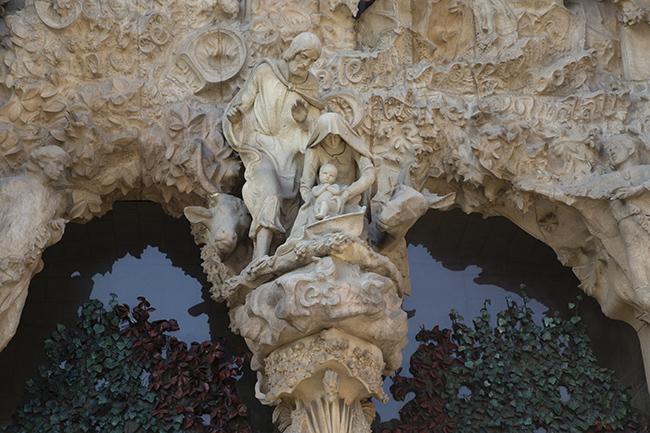
The central feature is the Door of Jesus which is overhung by the Tree of Life and nestled between those that represent Hope (on the left), Faith (on the right) and Charity (which is represented by the central portal) - these represent the three theological virtues.The materials which have been used in their construction are poly-chrome aluminum and glass and are they are decorated with motifs that are linked to the natural world with insects and small animals which are evocative of the place in which Jesus was born. The Door of Charity has been garlanded with ivy (the symbol of obedience) and pumpkin flowers (which symbolize marriage). The Door of Faith is adorned with wild roses without thorns (a reference to St. Francis of Assisi) and the Door of Hope is adorned with reeds, (like those that are found on the River Nile and which represent the Flight out of Egypt). The doors are separated by two columns: that of charity and the other which is dedicated to the Virgin Mary and are between the main door and the Door of Faith. At the foot of the columns, sea and land turtles have been sculpted as immutable symbols of the church and the strength of tradition in contrast with the chameleons, which represent change. Gaudí's innovative style is instantly recognizable in the details: the pillar of the column rises in a spiral whilst the capitals have the shape of palm leaves from which snow-covered clusters of dates remind us of the birth of Jesus which took place in winter. Here you will be able to distinguish four angels with trumpets announcing the birth of Christ. The genius of Barcelona's most famous architect is also revealed in all its eccentric spirit and it is believed that Gaudí used plaster transfers of deceased citizens of Barcelona as models for the portraits of his characters in order to ensure the uniqueness of each sculpture. The facade ends at the bell towers which are dedicated to St. Matthew, St. Jude, St. Simon and St. Barnabas.
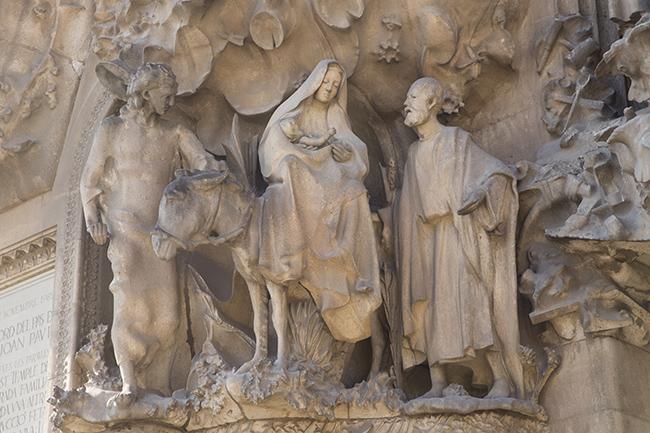
Antoni Gaudí, conscious of the fact that he would be unable to finish the immense work that constituted the Sagrada Familia, decided to dedicate himself to finishing the Facade of the Nativity in order to provide an over all idea of his project and to provide an example of how his works should be finished. He specifically chose this facade because, in his opinion, this would be the one that would prove most attractive to the public:
"If, instead of making this facade which is decorative, ornamental and turgid, I had started with the Facade of the Passion which is hard, naked and as if made of bones, people would have run away," he stated.
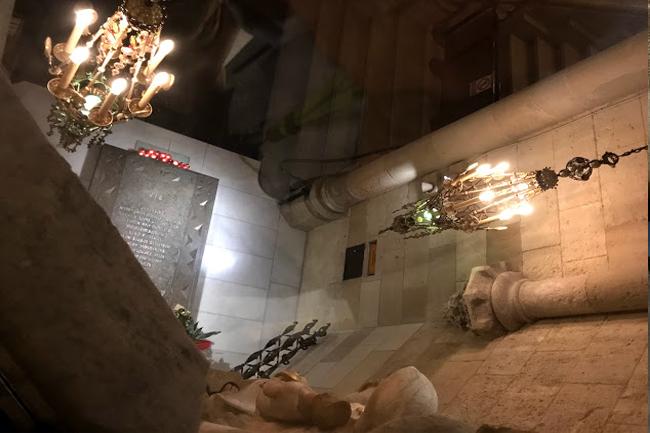
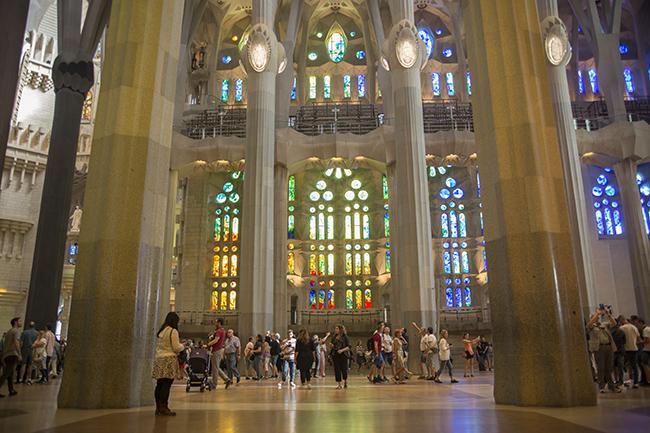
The crypt represents the very heart of the basilica, in fact, the church was originally designed with a Latin cross and the crypt is positioned to correspond precisely with the main altar, just at a lower level. This underground church features seven chapels which are dedicated respectively to: St. Joseph, the Sacred Heart, the Immaculate Conception, St. Joshua, St. Anne, St. John, St. Elizabeth and St. Zachariah. The seven chapels are laid out in a semi-circular format and in front of these are situated a further five chapels in a straight line: the central chapel is dedicated to the Holy Family and houses the altar which is presided over by a bas-relief of the Holy Family. Among the other chapels is one that is dedicated to Our Lady of Mount Carmel which is where Gaudí is buried. The entire crypt is surrounded by a Roman mosaic in which vines and wheat, symbols of the Eucharist and Mediterranean icons of fertility, can be seen. The holy water font in the crypt is made from large shells from the Philippines which were supplied by the Marquess of Comillas. The crypt is covered by a dome that represents the Annunciation of the Virgin Mary and is decorated with lamps, some of which were handmade by Gaudí himself.
If you would like to visit the Crypt of the Sagrada Familia, you can book directly on this page with a professional, experienced, English speaking private guide. If, however, you are only interested in a visit to the exterior of the Sagrada Familia, then we would recommend that you ask for one of our guided tours with a Local: They will be able to show you everything and explain in detail about the Facades of the Sagrada Familia which we have referred to in this article!
As I came up the steps from the Metro Line L2, I was looking at my mobile to work out which street I should take, however, I honestly couldn't avoid looking up and seeing it there in front of my eyes, so close, so vast and so beautiful, it took my breath away. I remember being utterly surprised by this imposing structure, almost with my mouth hanging open and I couldn't tear my eyes away from its towers which appeared to be touching the sky. Arriving at the entrance on the northeast side, despite having been warned about the large number of tourists, I was still surprised by the very long queue and gave a sigh of relief on seeing that our guide was skipping the queue in order to reach the doors of the Sagrada Familia directly. It may seem banal, but I have to say once again that I was astonished by its beauty.
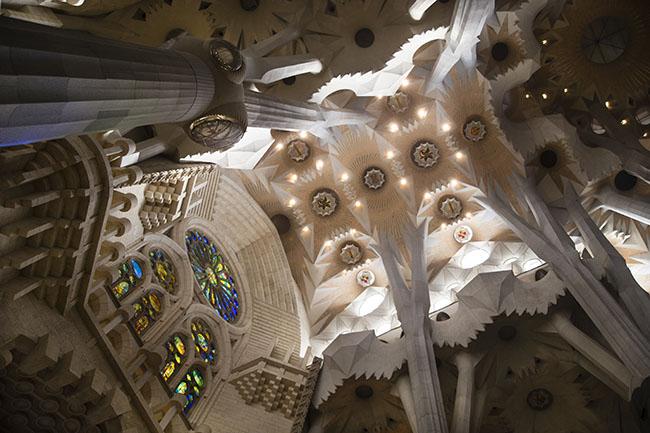
Now I found myself just a few steps away from the three entrance door and from the sculptures on the Facade of the Nativity. The majesty of the doors conveyed that typical sensation of when you feel really small in front of something utterly vast and powerful such as a stormy sea and yet, at the same time, the statues conveyed a sense of peace and serenity and were so detailed and evocative that they seemed almost real. Our guide described every detail of the facade and showed us how each statue tells part of the story of the birth of Christ. The details which made the greatest impression on me were: the softness of the Virgin's face and the flowers covered in snow which really conveyed the cold of winter when the baby Jesus was born. We then entered the basilica - I hadn't expected a building that was so full of light and I was surprised and delighted to hear that the majority of the light comes from sunlight!
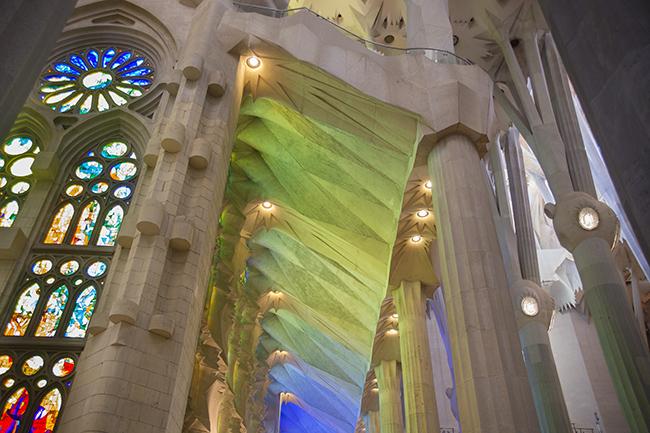
Together with our official guide, we also visited the Museum of the Sagrada Familia. During the visit, we found out just how much work and attention to detail had gone into this project of Antoni Gaudí. Without being over the top, one could almost say that every single individual stone had been calculated and positioned with a symbolic and evocative Christian thread in mind. But, it is well know that the mind selects and focuses its attention on different things and mine was completely fascinated by the discovery of Antoni Gaudí's fascination with botany. His passion and his studies of plants comes through in every one of his architectural works. Every detail, which had previously been invisible to me, was revealed by our expert guide who was at our side throughout the entire visit. The other detail that struck me was that Antoni Guadi's body lies in the Crypt of the Sagrada Familia and from a small window, you can see his tomb. This was really moving and very symbolic because the famous architect had dedicated almost his whole life to the construction of the Sagrada Familia.
My comments